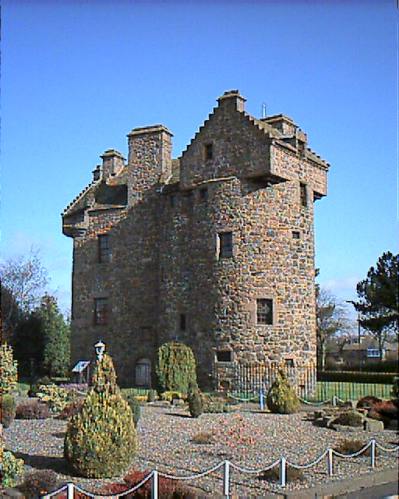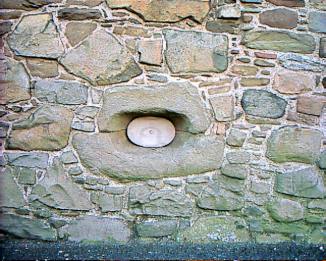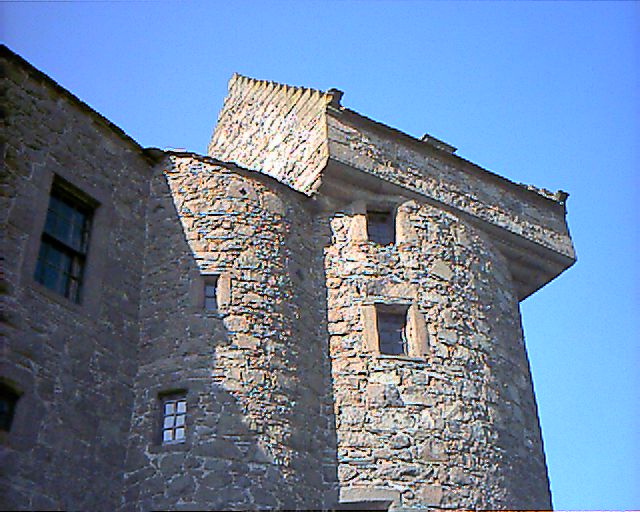
Claypotts Castle
The external features of the castle

The castle from the south-west
Although Claypotts is a relatively small castle, it is one of the most complete examples of a 16th-century `Z-plan' design. In outline, it is shaped rather like a letter `Z', as it has two projecting towers at diagonally opposite corners of a rectangular block. This allowed people defending the castle to fire across all the faces of the main building, so that anyone attacking the castle would be put off approaching it too closely!
As well as this defensive Z-plan arrangement, other defensive features of the castle can clearly be seen from outside the building. Near the bases of the walls there are several oval-shaped openings called gun ports, through which a gun could be fired by a defender inside the castle (see below, left). These holes expand outwards, and are very small on the inside, so it would have been very difficult for attackers to fire at the defenders from outside.
 One of the gun ports |
Decorative features at the wall-head, and tall chimneys |
Although it is clear that defence was important to the builders of Claypotts Castle, the building has also been given an attractive and striking appearance, including many decorative features. These can be appreciated by walking around the outside of the castle and looking up towards the tops of the walls. The castle has tall chimneys, crow-stepped gables, wall walks and other examples of appealing architectural design.
Above the doorway is a rectangular panel, which probably once contained the coat of arms of the castle's builder, John Strachan.

The photo above shows one of the garret chambers, its ends overlapping the walls of the tower underneath it. The gable ends (end walls) of the garret chambers are crow-stepped (the stones form small steps up to the top of the roof).
The castle's doorway (note the gun port right beside it - to discourage unwanted visitors!) |
This view from the north-east shows a variety of window shapes and sizes. There are few windows in the lower parts of the walls. |
If you look high up on the ends of the circular towers, there are stones called skewputs supporting the crow-stepped gables which have dates carved onto them. A skewput on the southern tower bears the date 1569, while another on the northern tower is dated 1588.
The southern tower also has a finely-decorated dormer window in its garret chamber. You can see this at the top of the photo below.

The southern tower, with a garret chamber on top and a decorated dormer window
The castle has many windows of different shapes and sizes. Those lower down in the walls tend to be smaller. From the east side of the castle you can see a group of small, diamond-shaped windows. These are set in a spiral stairway, and you will notice them when you climb the stairs inside.
There are several rainwater spouts projecting from the castle's walls (see below). These directed rainwater away from the walls of the building, because water running down the walls would have damaged them. It is interesting to look at these rainwater spouts from both outside and inside the castle. From inside, you can get a close-up view (below, right).
Projecting rainwater spouts, viewed from below |
One of the spouts, viewed through a garret window |
Claypotts Castle would originally have been surrounded by a busy courtyard, with other buildings, such as stores and stables, nearby. These are now gone, and some possibly lie underneath the modern housing estate near the castle.